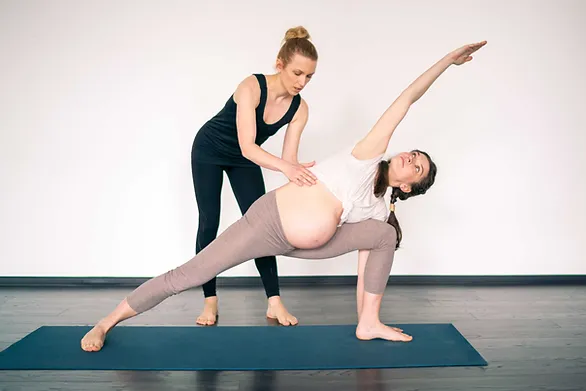Exercising during pregnancy brings significant benefits for both maternal and fetal health. Regular physical activity not only enhances cardiovascular fitness and improves sleep quality but also reduces the risk of complications such as gestational diabetes and high blood pressure. According to the American College of Obstetricians and Gynecologists (ACOG), pregnant women should aim for at least 150 minutes per week of moderate-intensity exercises like brisk walking, swimming, or prenatal yoga to maintain health and flexibility.
Brisk walking is a safe, easy-to-perform exercise that is suitable for all stages of pregnancy. With just 30 minutes a day, expectant mothers can improve blood circulation, reduce stress, and boost cardiovascular health. Walking also minimizes pressure on the joints and spine, which is particularly helpful as the baby grows. To ensure safety, it is advisable to choose smooth surfaces, wear comfortable athletic shoes, and avoid areas with obstacles or uneven terrain.
Swimming is an ideal form of exercise that relieves the extra pressure caused by body weight during pregnancy. The Centers for Disease Control and Prevention (CDC) affirm that gentle swimming for 30 minutes can help alleviate back pain, improve joint health, and enhance blood circulation. Specifically, breaststroke and walking in water strengthen muscles without straining the joints. “Swimming is the perfect exercise to help expectant mothers maintain overall health and enjoy relaxation throughout pregnancy.”

Prenatal yoga is an excellent option for pregnant women looking to maintain flexibility and emotional well-being. Yoga exercises gently stretch muscles, reduce back pain, and improve breathing, which helps prepare for labor. The International Journal of Obstetrics and Gynecology (IJOG) highlights that yoga also reduces anxiety and enhances sleep quality during pregnancy. However, pregnant women should avoid poses that involve prolonged lying on the back or those that may affect balance.
“Yoga not only keeps expectant mothers flexible but also teaches deep breathing techniques that aid in pain control and relaxation during labor.” — International Journal of Obstetrics and Gynecology, 2021.
Stationary cycling is another safe and effective exercise for pregnant women. Compared to outdoor cycling, stationary biking minimizes the risk of falls and injuries. This activity strengthens cardiovascular health, builds endurance, and reduces pressure on the pelvis. As the pregnancy progresses, raising the bike’s handlebars can help ensure a comfortable and safe riding posture.
Exercises that prepare the body for labor, such as squats and pelvic tilts, play a vital role in pregnancy fitness. Squats help open the pelvic area, making delivery easier, while pelvic tilts strengthen abdominal muscles and relieve lower back pain, which is common during the later stages of pregnancy.
Although exercising offers numerous benefits, expectant mothers should warm up gently for 5–10 minutes before starting and end with light stretching to prevent muscle strain. Wearing comfortable clothing, supportive athletic shoes, and staying hydrated throughout the session are essential. If any unusual symptoms such as dizziness, shortness of breath, abdominal pain, or bleeding occur, it is important to stop exercising immediately and consult a doctor.
Regular and safe exercise during pregnancy not only keeps expectant mothers healthy and energized but also supports optimal development for the baby. With just 20–30 minutes of exercise per day, mothers can experience significant improvements in physical health and mental well-being while preparing for a smooth and successful delivery.


HPX24h > Fitness > Exercise Tips for Pregnancy: Safe, Effective, and Beneficial for Mom and Baby
Tagged Articles
Why Do You Get Headaches After Exercise? Causes, Remedies, and Effective Prevention
Exercise – The Key to Enhancing Your Quality of Life
Can Pregnant Women Experience Temporary Memory Loss? The Secrets Behind Brain Changes During Pregnancy
Muscle Strain During Exercise: Effective Prevention and Recovery Tips
Top Reads from This Category
Fitness
Postpartum Fitness: Secrets to Maintaining an Active Routine for a Quick Recovery
Fitness
Safe Exercises for Early Pregnancy: Tips to Keep Moms Healthy and Strong
Fitness
Ketosis: The Key to Accelerating Effective Fat Burning
Fitness
Effective And Safe Methods To Strengthen Your Knees: Proven Tips For Optimal Performance
Fitness
Exercise – The ‘Miracle Cure’ to Awaken Overall Health
Fitness
How Often Should You Work Out Each Week for Effective Weight Loss and Muscle Gain?
Fitness
Swimming: The Golden Key to Physical and Mental Well-Being
Discover New Topics
Parenting Tips
Talking To Children About Sexuality: How To Make It Easier?
Fitness
HIIT Training: A Long-Term Remedy for Brain Health
Health
The Best Days to Get Pregnant: How to Accurately Time Your Ovulation?
Science
New Discovery: How the Brain Manages Emotions and Memory
Healthy Eating
Why Do We Need Fiber in Our Diet?
Animals
The Potential of Black Mamba Venom in Developing New Painkillers
Science
Stem Cells and Gut Cultures: Unlocking New Possibilities for Treating Digestive Disorders
Healthy Eating
Foods That Support Depression Reduction: The Latest Scientific Nutritional Choices
Animals
Can Hyena Dogs Be as Smart as Primates?
Health
E. Coli In The Gut May Trigger A ‘Chain Reaction’ Leading To Parkinson’s Disease
Animals
Why Bedbugs Thrive Through Inbreeding
Parenting Tips
How to Talk to Your Child About Smoking Issues
Parenting Tips
The Way to Help Preschoolers Understand How Babies Are Made